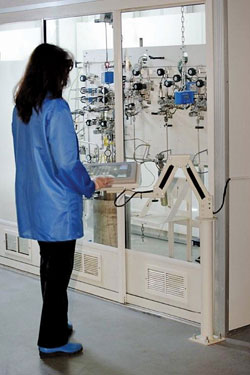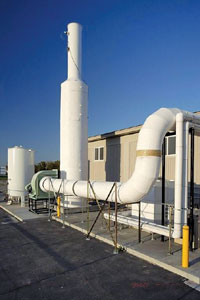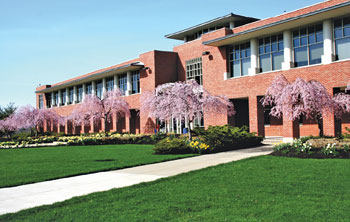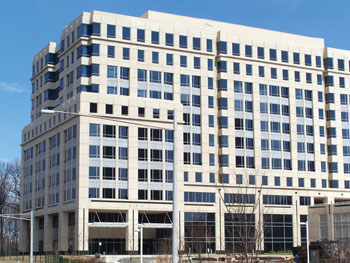
adam.bruns bounce@conway.com

orth-central New Mexico may appear to have a corner on the state’s nuclear industry marketplace, what with the national labs at Los Alamos and Sandia.
But the southeast New Mexico area around Hobbs, near the Texas state line in Lea County, is making its own claim to isotopic expertise. Already the home of a uranium enrichment operation about to come online from URENCO subsidiary Louisiana Energy Services (LES), the area on March 31 welcomed a $93-million investment from International Isotopes Inc. (INIS), which will build a depleted uranium de-conversion and fluorine extraction processing facility that could employ up to 150 people.
Being welcomed was a key criterion for INIS, which whittled down its initial site list to finalists in eastern Idaho; Andrews County, Texas; and Lea County.
“We were actally looking everywhere they’re already handling materials of this type,” says Steve Laflin, INIS president and CEO. “Washington State, around Honeywell facilities within USEC, back to the [North] Carolina coast where GE is located – we considered all of those regions as possible.”
But “probable” is another story.
“One key consideration is the political atmosphere in some of those regions,” Laflin says, “the history of whether others have succeeded or failed, or encountered a lot of public opposition. Regardless of grading criteria to sites, we will absolutely not go anywhere we would not be welcomed as a new addition to the community.”
The plant will occupy approximately 5 percent of a 600-acre (243-hectare) site, with the rest functioning as buffer space, well beyond Nuclear Regulatory Commission (NRC) requirements. However, says Laflin, it’s important to note that the facility will function more like a chemical plant than a nuclear facility. Because the material the firm is dealing with is depleted uranium, he says, “Most of the security hazards at our facility will be associated with the security requirement of chemicals we’ll possess, rather than the radiological consequences.”
Those chemicals include compounds INIS will sell wholesale, which will then be sold for industrial end uses ranging from aluminum and refrigerant manufacturing to the chemical vapor deposition methods used by electronics manufacturers to etch designs on chips or photovoltaic materials.
A range of specialty gases will be produced using patented processes to extract fluorine from depleted uranium hexafluoride, or DUF6. Those DUF6 “tails” will be coming from uranium enrichment operations currently in various stages of development across the country by such organizations as GE-Hitachi, AREVA, LES and the U.S. Dept of Energy. It may take those plants more than two decades to process existing stockpiles – which means a steady supply of DUF6.
The LES plant just east of Eunice, to the southwest of Hobbs, was authorized in late February by the NRC to receive its first shipment of uranium hexafluoride, and plans to begin commercial production sometime in 2009.
Laflin says the material must be de-converted to a chemically stable oxide form for safe disposal. He says his company is the only one ready to serve this niche: “The real advantage for us is we can do more than simply convert it,” he says. “We can produce commercial products, and that’s because of the patent we hold.”
Some of the plant’s equipment and design in New Mexico will come from the assets INIS purchased in 2008 from Sequoyah Fuels Corp., which owned a uranium deconversion facility in Oklahoma that had been idle since 1993.
Laflin would not elaborate on the company’s statement at the time of the announcement

that “INIS is currently evaluating several paths to raise the capital that will be necessary for the project,” including possible agreements with companies involved in enrichment or interested in procuring de-conversion products. The company is also investing $10 million and will hire 20 for a demonstration facility in Idaho, which could start operations as early as mid-2010.
Laflin praises the collaboration among the city, county and state government agencies with which INIS has conferred in New Mexico. Their partnership may take its most notable shape in educational opportunities, a sweet spot for INIS, which reimburses 100 percent of any higher education for its employees.
“The University of New Mexico, University of the Southwest and New Mexico Junior College in Hobbs have worked with LES to develop a nuclear technician training program,” says Laflin. The junior college received NRC grants for the program in 2007 and 2008. “We looked at that curriculum, and it was so broad and well thought out, we thought it would suit our needs as well, without any modification.”
n the same day in early April, private student lender Sallie Mae and telecom giant Verizon Wireless announced major new contact-center job-creation projects, amid renewed attention on the sector as a steady creator of decent jobs.

The Verizon project will be a new 141,805-sq.-ft. (13,174-sq.-m.) building attached to its existing campus in Alpharetta, Ga., the same community where a recently inaugurated amphitheater bears the Verizon Wireless name. The expansion will create 600 jobs and attract an investment of $27 million.
That’s the same number of new jobs coming to Sallie Mae’s facility in Wilkes-Barrie, Pa., as the lender announced it would return approximately 2,000 overseas contact-center and back-office jobs to the U.S. from overseas by the end of 2010. The move from sites in the Philippines, India and Mexico will cost the firm US$35 million a year. It comes at a time when the Obama administration’s budget plan calls for axing federal subsidies to private lenders and providing the loans directly.
Other locations in Sallie Mae’s 20-site U.S. network that figure to benefit from its jobs shift include sites in Killeen, Texas; Fishers, Ind.; and its newest facility in Newark, Del., which already was planning to hire as many as 1,100 by the end of 2011. That same city in late February welcomed the announcement of 300 new jobs at a new 70,000-sq.-ft. (6,500-sq.-m.) contact center from Barclaycard US, part of plans by Barclays to hire as many as 500 over the next five years in the state, where the bank employs 1,300 overall. The facility in Ogletown formerly was operated by MBNA.
Sallie Mae employs 8,000 nationwide, servicing the needs of 10 million customers with approximately $180 billion in student loans.
The town of Fishers in early April also welcomed the announcement of a new campus from Fort Wayne-based Indiana Tech, which will open in fall 2009 with a focus on career-oriented undergraduate and graduate programs. Fishers is on the outskirts of Indianapolis, one of several locations in the Americas cited by KPMG in a February report on 31 newly emerging locations across the globe for outsourcing work. Others in North America included Boise, Idaho; Winnipeg, Manitoba; Calgary, Alberta; Guadalajara, Jalisco, Mexico; and Queretaro, Mexico.
“There are many locations around the world which are able to supply a credible outsourcing capability,” said Edge Zarrella, global head of IT Advisory at KPMG and a partner in the Hong Kong firm. “However, there are subtle nuances in terms of labor skills, niche specialisms and government incentives which have led us to highlight these 31 locations as stars of the future.”
n a quick sequence of announcements spanning exactly seven weeks, Hilton Hotels Corp. moved its global headquarters from Beverly Hills, Calif., to the Greater Washington, D.C., area, signing a 10-year lease for one-third of the 11-story, 323,000-sq.-ft. (30,000 sq.-m.) Park Place II building in the Tysons Corner area of McLean in Fairfax County, Va.
“Potential locations were evaluated against multiple criteria including costs, proximity to Hilton’s U.S. and international offices, and talent attraction and retention,” read the company’s original announcement of its plans on January 21. “Relocating to the D.C. area will significantly reduce our operating expenses and will position Hilton in a more central location from which to operate a global business, ease coordination across our organization, and better enable us to execute on strategic opportunities,” said Christopher J. Nassetta, president and CEO.
Two weeks later, the site search had narrowed to Fairfax County, after evaluating offers from Maryland and the District of Columbia. But the final property choice had yet to be made. The signing of the lease took place on March 11.

Hilton will invest at least $17 million in the move and create more than 300 jobs in Fairfax County within the next 36 months. The incentive program totals $4.6 million in cash grants and other incentives. The company also qualifies for a Major Business Facility Job Tax Credit.
“We are fortunate to have had the opportunity to work with Hilton on this decision,” said Gerald L. Gordon, Ph.D., president and CEO of the Fairfax County Economic Development Authority. “In addition to enhancing the local tax base and improving the quality of life for our residents, this announcement greatly enhances the prestige of Fairfax County as a location for further business growth.”
The Park Place II building is LEED-Gold certified, which dovetails with Hilton’s recently announced sustainability goals.
But proximity to amenities may have been important too: The building, owned by the B.F. Saul Real Estate Investment Trust, is directly adjacent to the Hilton McLean Tysons Corner.”
Site Selection Online – The magazine of Corporate Real Estate Strategy and Area Economic Development.
©2009 Conway Data, Inc. All rights reserved. SiteNet data is from many sources and not warranted to be accurate or current.